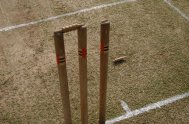
 |
| Index | |
|
|
|
|
|
| Wicket down, Breaking the wicket  'The wicket is put down' is how the Laws describe what most non-cricketers would call the wicket 'being broken'. The wicket is down when a minimum of one bail has been completely removed from its usual position on top of the stumps The important word is completely. Suppose the bowler bowls a ball that hits the stumps, causing the bail to jump in the air and come back to rest in its normal position. Even though it was removed just for an instant, that removal was not permanently completed, since the bail ended up back where it started, so the striker would not be out The bail might be disturbed and come to rest askew the top of the stumps, or perched precariously on just one of them. Again, though it was certainly not in its usual position, it was not completely removed from the top of the stumps and the batter would be Not out However, if the bail slipped down and lodged between two stumps, the batter would be given out Bowled on appeal, because the bail had been completely removed from the top of the stumps These examples do not happen as rarely as many people think! Sometimes a situation occurs in which one bail has already been removed - perhaps there might have been an earlier unsuccessful attempt at a Run out, or stumping, for example. If the wicket needs to be put down again, it's enough just to remove the other bail, or to strike a stump or pull it out of the ground, providing that the fielder uses the ball or the hand holding the ball or the same arm to do so |
||||||